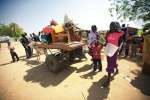- Text size
 |
|  |
|  |
| 
- Français
Refugees arriving in South Sudan's Upper Nile State cite daily bombings, difficult escapes, food scarcity
Briefing Notes, 5 June 2012
This is a summary of what was said by UNHCR spokesperson Andrej Mahecic – to whom quoted text may be attributed – at the press briefing, on 5 June 2012, at the Palais des Nations in Geneva.
Over the past three weeks an estimated 35,000 refugees from Sudan's Blue Nile state have sought asylum in South Sudan, many of them citing harrowing experiences along the way.
Refugees continue to describe aerial bombardments and ground fighting between Sudan Armed Forces and Sudan People's Liberation Army (North) forces, as well as growing conflict-induced food shortages. Unconfirmed accounts speak of escape routes being blocked.
Refugees also describe being forced to flee several times within Blue Nile state before making it to South Sudan. Sheikhs (traditional chiefs) report that they hosted displaced tribes in their villages until distant bombings came closer and became a daily occurrence, prompting them to flee. They say bombings took place at night and in the early morning, forcing people to take cover in dry streams, caves, and dense forest. Village leaders also describe journeys lasting several weeks because the elderly and the very young who suffered swollen feet and legs could not keep up.
The large number of new arrivals is adding pressure to an already difficult humanitarian situation in this part of South Sudan. The most critical challenge for aid agencies is to provide enough clean water for all refugees and to prevent disease. Partner humanitarian agencies are trucking water to refugee sites, while five rigs are operational and drilling efforts are continuing. We are working with the local authorities to identify more sites with reliable water sources to ease pressure on existing refugee settlements. Difficult road conditions are slowing the delivery of assistance.
UNHCR has been sending emergency supplies to South Sudan by air and by road since December. This includes 10,000 family tents, more than 52,000 plastic sheets, over 100,000 sleeping mats, over 160,000 blankets, more than 90,000 mosquito nets, some 80,000 jerry cans and 55,000 kitchen sets. Based on current stocks in the regional warehouse in Nairobi, we are prepared to respond to the needs of an additional 50,000 refugees.
Including the new arrivals, South Sudan is currently hosting some 150,000 refugees from Sudan. Over 105,000 of these are in Upper Nile State, while a further 47,000 are in settlements further west in Unity State.
For more information on this topic, please contact:
- In Maban: Pumla Rulashe on mobile +211 922 407 462
- In Juba: In Juba: Terry Ongaro on mobile: +211 927 770 040
- In Nairobi: Vivian Tan on mobile +254 735 337 608
- In Geneva: Fatoumata Lejeune-Kaba on mobile +41 79 249 3483

















































